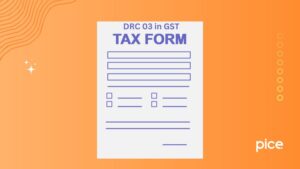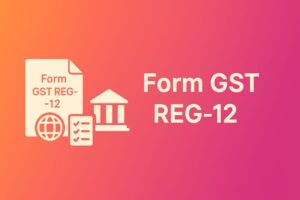Documents Required for Sole Proprietorship Registration in India
- 30 Aug 24
- 10 mins
Documents Required for Sole Proprietorship Registration in India
Key Takeaways
- Core Documents for GST: Sole proprietorships need an Aadhaar card, PAN card, bank account details, and proof of the registered office for GST registration.
- Streamlined Registration: The GST registration involves an 8-step process on the official portal, from entering details to downloading the GST certificate.
- Mandatory Criteria: Sole proprietors must register for GST if their annual turnover exceeds ₹40 lakhs (₹20 lakhs in Northeastern states) or if they engage in inter-state commerce.
- Key Benefits: GST registration provides legitimacy, input tax credits, simplifies interstate business, and boosts competitive advantage and credibility.
- Timely Registration: Register within 30 days of business commencement or crossing the threshold to avoid penalties.
A sole proprietorship is a business model where one person, the proprietor, handles ownership, management and control of all business activities. From local vendors to small shop owners, many operate under this business model. These business owners often choose to register their businesses as sole proprietorships to secure legal protection.
In India, sole proprietor registration not only simplifies operations but also grants legal recognition to the business. This blog explores the essential documents required for GST registration for proprietorship and provides a step-by-step guide to the seamless registration process. Delve in to learn how to navigate these steps effortlessly and establish your business for success!
Constitution of Business

The documents required for GST registration vary based on the constitution of the business or the business structure. For instance, the documents required for a sole proprietorship are different from those of a company or partnership firm. Learn about the common documents required for GST registration for proprietorship in the upcoming section.
GST Registration Documents List for Proprietorship
There are 4 core documents that you require for GST registration for sole proprietorship. Here are the documents required for GST registration for proprietorship that must be kept handy:
- Aadhaar Card
An Aadhaar card acts as an address verification proof for the sole proprietor's place of residence. As a result, it is one of the mandatory documents for GST registration. You can apply for an Aadhaar card to receive a hard copy within 15 to 20 days from the application date.
- PAN Card
A PAN card acts as the identity proof of the proprietor. It is an essential document when it comes to filing income tax returns. You can apply for a PAN card online and get the hard copy within 15 to 20 days. However, you can receive your PAN card number on the NSDL portal within 7 to 8 days from the date of application.
- Bank Account
As a proprietor, you can visit your nearest bank or your preferred bank to open a current account. The documents you need to submit to open the account include a PAN card, an Aadhaar card and a GST registration certificate. In this case, your PAN card will act as your identity proof and your Aadhaar card will act as your address proof.
- Registered Office Proof
You may operate your sole proprietorship business from your self-owned property or a rented property. In case it is a rented property, you will require a rent agreement or rental agreement followed by an NOC or No-Objection Certificate from the landlord.
On the other hand, if it is a self-owned property, you will need to submit a copy of a utility bill such as an electricity bill, gas receipt or other similar documents not older than 2 months from the date of application.
How to Proceed with GST Registration?

The GST registration process is seamless and hassle-free if you know the step-by-step procedure. Here’s how you can register your sole proprietorship business under the current GST regime:
Step 1: Visit the official GST portal and navigate to the ‘Services’ option. Select ‘Registration’ under the ‘Services’ tab and then ‘New Registration’.
Step 2: Enter the prompted details such as PAN number, state, district, your operational mobile number and email address. Further, enter the OTP you receive and click on ‘Proceed’ to receive the TRN (Temporary Reference Number).
Step 3: Go back to the home page of the GST portal, and click 'Services', 'Registration' and 'New Registration' in sequence.
Step 4: Enter the TRN and captcha prompted correctly before you click on ‘Proceed’ and fill in the draft application form.
Step 5: Verify the details entered and submit the application form using a digital signature certificate.
Step 6: Application reference number or ARN generation and issuance of acknowledgement receipt is the sixth step of the process. Ensure you keep the ARN if you need to refer in the future.
Step 7: This step includes verification by the GST authorities prior to approval.
Step 8: When the GST authorities approve the application, they will issue the GST certificate which is ready for you to download.
There are 10 sections in the application form which you need to fill in, as follows:
- Business details: Fill in the trade and legal names, constitution of business and tax jurisdiction. Alternatively, you can choose Aadhaar authentication to get approvals faster.
- Authorised Signatory: The application form offers an option to choose the authorised signatory. In the case of sole proprietorship, the proprietor is the authorised signatory and hence you need to choose the 'Also Authorised Signatory' option in the previous section while filling in the application form.
- Primary Place of Business or Business Premise: Fill in the business address including the building name, street name, floor number, city and pin code. Additionally, you need to upload proof of ownership for the place of business. The proof can include a rent agreement, property tax receipt or utility bills. Further, select the nature of business activities from options like manufacturers, service providers, traders and others for your business entity.
- Additional Place of Business: If your business has other units, branches, warehouses or godowns, you need to declare that in the application form and upload supporting and relevant documents. However, if you do not have an additional place of business, you can skip this section.
- Goods and Services: This section of the application form mandates the selection of the HSN code for goods and the SAC code for services that you operate your business with. The form allows the selection of up to 5 goods and services each.
- Bank Accounts: In this section, you need to fill in your bank account details including account number, IFSC code, bank and branch names and branch address. As proof of bank details, you need to upload a copy of the bank passbook, bank statement or cheque. The passbook and statement reflect financial transactions with the bank in addition to the other details.
- State Specific Information: This section mandates filling in professional tax registration details followed by state excise licence or drug licence. However, this section differs based on the state in which the sole proprietor operates.
- Verification: The final step of filling in the application form is verifying all the entered information and submission of documents followed by the application form. As a business owner or sole proprietor, you can submit the form using e-signature or EVC. For e-signature, your Aadhaar number needs to be linked to your mobile number, while for EVC, your PAN and mobile number need to be registered on the GST portal.
Step 5: Once you are done filling up the form, verify the details entered and submit the application form using a digital signature certificate, e-signature or EVS facility.
Step 6: You will receive an Application Reference Number (ARN) via mobile and email. You can use this ARN to track your application's status on the GST portal.
Following this, a GST officer will review your application form. Upon successful verification, your application will be approved, and you will receive your GSTIN and GST registration certificate via your registered email. You can also download them from the GST portal.
Time Limit for GST Registration
A sole proprietor needs to register for GST within 30 days from the business commencement date or threshold limit crossover date, whichever is earlier. In case a proprietor fails to register within the time limit, he or she may face a penalty of ₹10,000 or 10% of the total tax due, whichever is higher.
Is It Mandatory to Have a GST Licence for a Sole Proprietor Firm?

A GST licence is not mandatory for a sole proprietorship firm in India unless the firm meets certain conditions. Here are the conditions that make GST licence mandatory for a sole proprietorship firm in India:
- If the annual turnover threshold limit exceeds ₹40 lakhs, GST registration is mandatory. However, this limit is set at ₹20 lakhs for sole proprietors from Himachal Pradesh and Northeastern states.
- GST registration is mandatory if the sole proprietor engages in inter-state supply and sale of goods and services or is involved in e-commerce operator activities.
Alternatively, sole proprietors can voluntarily register for GST if the annual turnover limit is not met. This helps them expand their business and improve credibility.
Benefits of GST Registration for Proprietorship
There are multiple benefits of GST registration for proprietorship firms. Some of these benefits are discussed below:
- Legitimacy and Compliance: GST registration helps a sole proprietorship firm establish its legal framework. It further helps ensure tax compliance, thereby building a credible reputation among customers.
- Input Tax Credit: GST registration allows proprietorship firms to claim input tax credit. This further reduces the tax burden and increases the cash flow for the firm.
- Interstate Transactions: The registration helps proprietorship firms eliminate the complexities of state taxes by helping them comply with mandatory legal frameworks. Further, it helps the firm avoid penalties due to non-registration.
- Competitive Advantage: It ensures a competitive advantage for sole proprietorship firms. The competitive advantage results in other unregistered proprietorship firms being less credible among their customers.
Conclusion
The list of documents required for GST registration for proprietorship is simple and readily accessible. If your proprietorship meets the GST criteria, registering is essential to avoid penalties. Alternatively, if your firm does not meet the criteria you can voluntarily register for GST with the simple documentation process for business growth through expansion and business operation.
💡 If you want to pay your GST with Credit Card, then download Pice Business Payment App. Pice is the one stop app for paying all your business expenses.
 By
By 

















